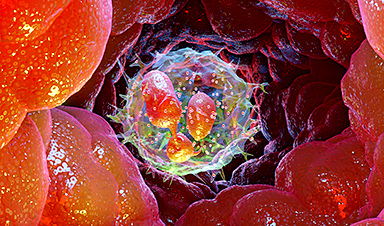Using lasers to precisely control white blood cells in living fish, researchers have demonstrated that some of the body’s native cells can be “remotely controlled” to accomplish a variety of tasks in a highly precise way. These tasks may someday include biomedical applications such as targeted drug delivery and the precise treatment of inflammatory diseases.
The research team, which included Baojun Li, PhD, and Xianchuang Zheng, PhD, from Jinan University in China, successfully used light-controlled neutrophil “microcrafts” to guide intercellular connections, deliver nanomedicines, and eliminate cell debris in a targeted way. They reported their results in an ACS Central Science article (“Optically Manipulated Neutrophils as Native Microcrafts in Vivo”).
The researchers’ current work overcomes these obstacles. They used neutrophils—cells already present in the body—to avoid setting off an immune reaction. The neutrophils also have the natural ability to migrate through blood vessels and into adjacent tissues.
“Unlike traditional medical microdevices, this neutrophil microcraft is free from artificial microstructures and invasive implantation processes,” the researchers pointed out. “It exhibits high biocompatibility [and] minor immunogenicity.”
Earlier studies had shown that neutrophils could be guided with lasers in lab dishes, moving them around as “neutrobots.” But until now, the feasibility of this approach had not been explored in living animals.
In the current study, the researchers maneuvered neutrophils in the tails of live zebrafish, using focused laser beams as remote optical tweezers. The light-driven microrobots could be moved up to a velocity of 1.3 µm/s, which is three times faster than a neutrophil naturally moves.
They used the optical tweezers to precisely and actively control the functions that neutrophils conduct as part of the immune system. For example, they moved a neutrobot through a blood vessel wall into the surrounding tissue. They manipulated another one to pick up and transport a plastic nanoparticle, showing its potential for carrying medicine. And when the researchers pushed a neutrobot toward red blood cell debris, it engulfed the pieces. Surprisingly, at the same time, a different neutrophil, which wasn’t controlled by a laser, tried to naturally remove the cellular debris.
This work paves the way for the development of microrobots for in vivo biomedical applications, such as the targeted delivery of drugs and the precise treatment of diseases. “This concept [holds] great promise for the active execution of complex medical tasks in vivo, with great potential utility in the treatment of inflammatory diseases,” concluded the researchers.
News
New Once-a-Week Shot Promises Life-Changing Relief for Parkinson’s Patients
A once-a-week shot from Australian scientists could spare people with Parkinson’s the grind of taking pills several times a day. The tiny, biodegradable gel sits under the skin and releases steady doses of two [...]
Weekly injectable drug offers hope for Parkinson’s patients
A new weekly injectable drug could transform the lives of more than eight million people living with Parkinson's disease, potentially replacing the need for multiple daily tablets. Scientists from the University of South Australia [...]
Most Plastic in the Ocean Is Invisible—And Deadly
Nanoplastics—particles smaller than a human hair—can pass through cell walls and enter the food web. New research suggest 27 million metric tons of nanoplastics are spread across just the top layer of the North [...]
Repurposed drugs could calm the immune system’s response to nanomedicine
An international study led by researchers at the University of Colorado Anschutz Medical Campus has identified a promising strategy to enhance the safety of nanomedicines, advanced therapies often used in cancer and vaccine treatments, [...]
Nano-Enhanced Hydrogel Strategies for Cartilage Repair
A recent article in Engineering describes the development of a protein-based nanocomposite hydrogel designed to deliver two therapeutic agents—dexamethasone (Dex) and kartogenin (KGN)—to support cartilage repair. The hydrogel is engineered to modulate immune responses and promote [...]
New Cancer Drug Blocks Tumors Without Debilitating Side Effects
A new drug targets RAS-PI3Kα pathways without harmful side effects. It was developed using high-performance computing and AI. A new cancer drug candidate, developed through a collaboration between Lawrence Livermore National Laboratory (LLNL), BridgeBio Oncology [...]
Scientists Are Pretty Close to Replicating the First Thing That Ever Lived
For 400 million years, a leading hypothesis claims, Earth was an “RNA World,” meaning that life must’ve first replicated from RNA before the arrival of proteins and DNA. Unfortunately, scientists have failed to find [...]
Why ‘Peniaphobia’ Is Exploding Among Young People (And Why We Should Be Concerned)
An insidious illness is taking hold among a growing proportion of young people. Little known to the general public, peniaphobia—the fear of becoming poor—is gaining ground among teens and young adults. Discover the causes [...]
Team finds flawed data in recent study relevant to coronavirus antiviral development
The COVID pandemic illustrated how urgently we need antiviral medications capable of treating coronavirus infections. To aid this effort, researchers quickly homed in on part of SARS-CoV-2's molecular structure known as the NiRAN domain—an [...]
Drug-Coated Neural Implants Reduce Immune Rejection
Summary: A new study shows that coating neural prosthetic implants with the anti-inflammatory drug dexamethasone helps reduce the body’s immune response and scar tissue formation. This strategy enhances the long-term performance and stability of electrodes [...]
Scientists discover cancer-fighting bacteria that ‘soak up’ forever chemicals in the body
A family of healthy bacteria may help 'soak up' toxic forever chemicals in the body, warding off their cancerous effects. Forever chemicals, also known as PFAS (per- and polyfluoroalkyl substances), are toxic chemicals that [...]
Johns Hopkins Researchers Uncover a New Way To Kill Cancer Cells
A new study reveals that blocking ribosomal RNA production rewires cancer cell behavior and could help treat genetically unstable tumors. Researchers at the Johns Hopkins Kimmel Cancer Center and the Department of Radiation Oncology and Molecular [...]
AI matches doctors in mapping lung tumors for radiation therapy
In radiation therapy, precision can save lives. Oncologists must carefully map the size and location of a tumor before delivering high-dose radiation to destroy cancer cells while sparing healthy tissue. But this process, called [...]
Scientists Finally “See” Key Protein That Controls Inflammation
Researchers used advanced microscopy to uncover important protein structures. For the first time, two important protein structures in the human body are being visualized, thanks in part to cutting-edge technology at the University of [...]
AI tool detects 9 types of dementia from a single brain scan
Mayo Clinic researchers have developed a new artificial intelligence (AI) tool that helps clinicians identify brain activity patterns linked to nine types of dementia, including Alzheimer's disease, using a single, widely available scan—a transformative [...]
Is plastic packaging putting more than just food on your plate?
New research reveals that common food packaging and utensils can shed microscopic plastics into our food, prompting urgent calls for stricter testing and updated regulations to protect public health. Beyond microplastics: The analysis intentionally [...]





















